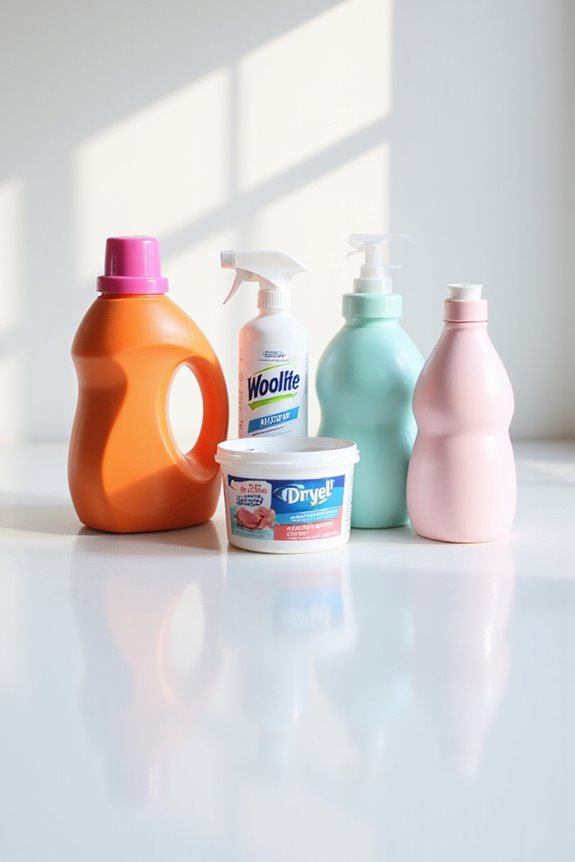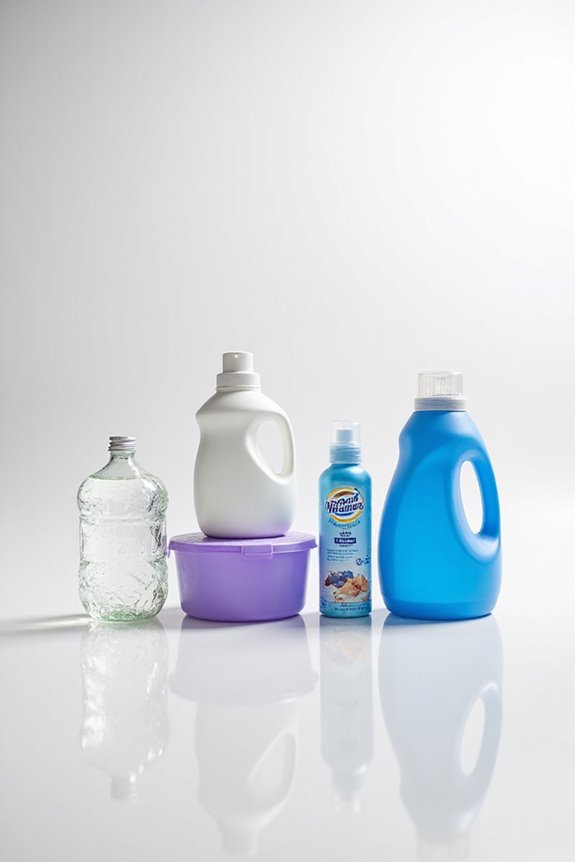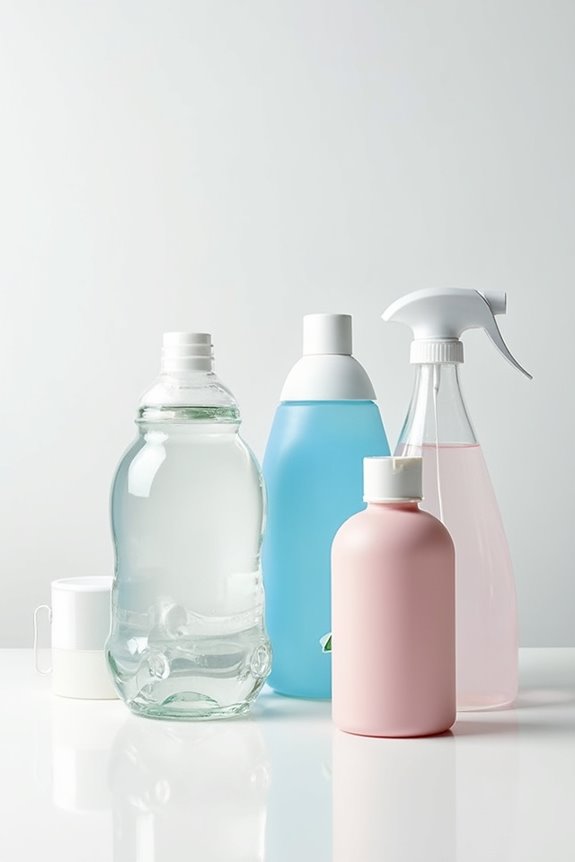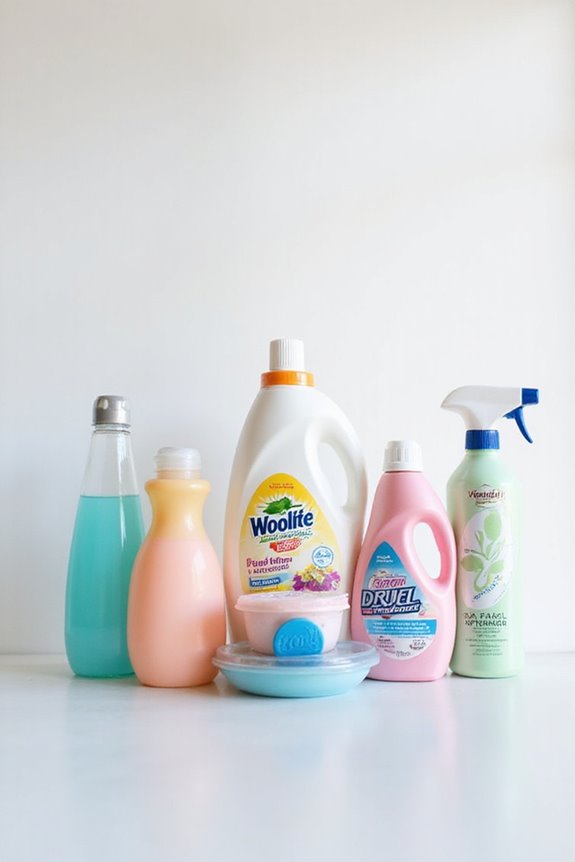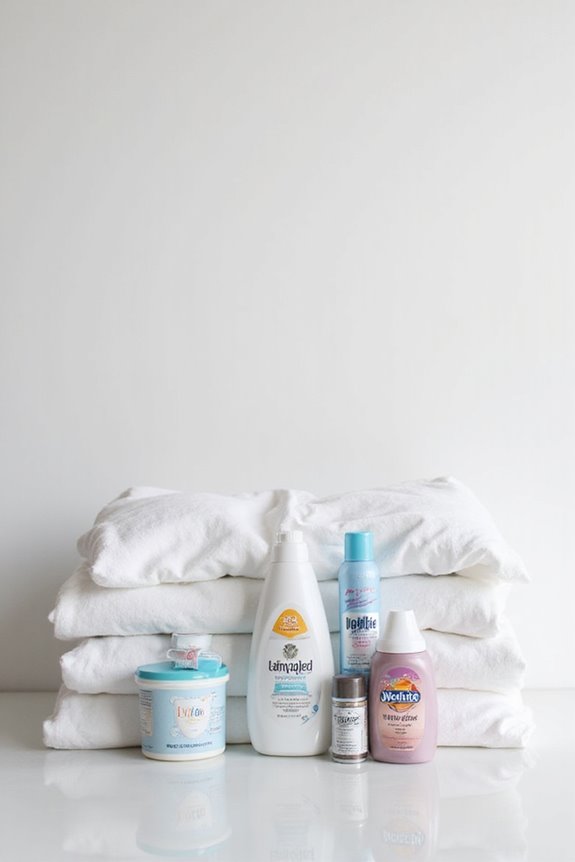To remove detergent stains from clothes, we can start by soaking the item in warm water. Next, apply an enzyme-based stain remover, rubbing it gently into the stain. After letting it sit for about 15 minutes, rinse it with warm water. If we still see the stain, a vinegar solution or a baking soda paste might help. Remember, using the right amount of detergent is key! There’s more easy tips to guarantee our clothes stay stain-free.
Key Takeaways
- Soak the stained garment in warm water to help dissolve the detergent residue effectively.
- Apply an enzyme-based pretreatment directly to the stain and let it sit for 10-15 minutes.
- Use a vinegar solution (equal parts vinegar and water) to blot the stain from the outside in.
- Create a paste with baking soda and water, applying it directly to the stain before washing.
- Rinse stained areas with cold water immediately after spotting to prevent setting the stain.
Understanding Detergent Stains
When we think about laundry, we often picture fresh-smelling clothes, but sometimes, we end up with those pesky detergent stains instead. These stains usually come from detergent residue, particularly surfactants that don’t wash away completely. Surfactant interaction with water is meant to trap oils and dirt, but if we use too much detergent or have hard water, those surfactants can form stubborn deposits on our fabrics. We might notice a cloudy film or even greasy spots that dull our favorite shirts. Using lower temperatures can make it worse, too, as the detergent doesn’t dissolve fully. So, next time we’re loading the machine, let’s keep an eye on the detergent amount and our water conditions to avoid those unwelcome surprises! Additionally, using enzyme-powered detergents can help prevent such residue by effectively breaking down stains during the wash cycle.
Initial Treatment and Pretreatment Methods
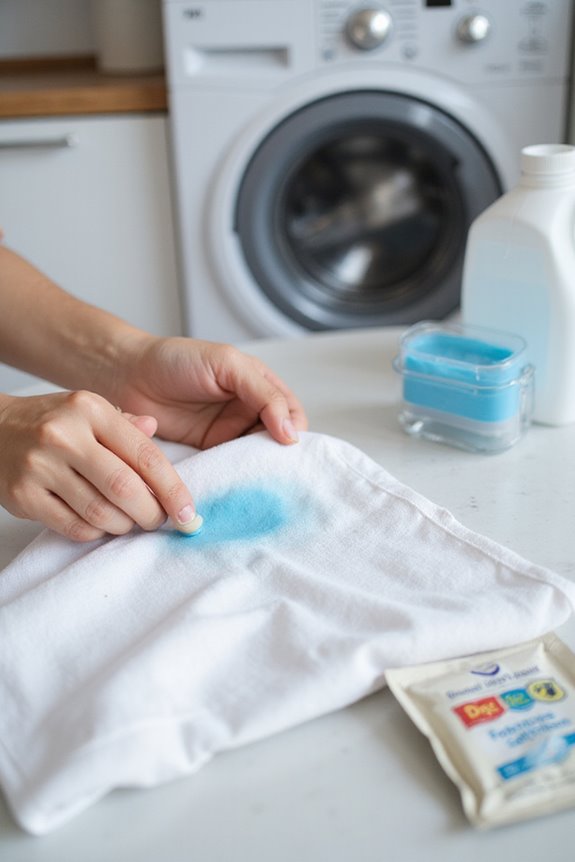
Detergent stains can be frustrating, but don’t worry! We can tackle them together. First, let’s start with initial soaking. Use the warmest water your garment’s care label allows. This helps loosen that pesky detergent residue. We recommend soaking for a bit before moving on to the next step.
Next, it’s time for enzyme application. Grab an enzyme-based or oxygen-based pretreatment and apply it directly to the stain. Gently rub it in with your fingers or a clean cloth—our hands can work wonders! Let it sit for 10 to 15 minutes; we want those enzymes to do their job. In fact, enzymes act as biological catalysts for stain breakdown and can significantly improve the effectiveness of your treatment. After that, rinse with warm water, and check if the stain’s gone. If not, repeat!
Effective Household Remedies
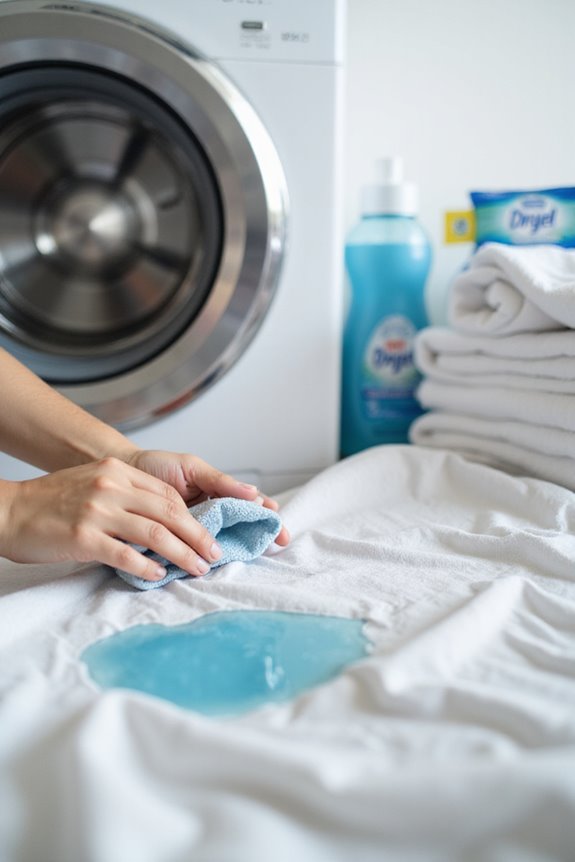
Even if we’ve already soaked and treated our clothes, some detergent stains can still be pesky. One effective option is a vinegar solution. By mixing equal parts white vinegar and water, we can create a cleaning solution that breaks down those stubborn residues. Let’s apply it with a clean cloth, blotting gently from the outside in.
Another great remedy is baking soda. Mixing baking soda with water to form a paste can help lift stains without damaging the fabric. We can apply it directly to the stain before washing. Baking soda is effective on organic stains like blood, making it a versatile cleaning agent.
If all else fails, rubbing alcohol can also work wonders. Just dampen a cloth with it, rub gently, and wash normally afterward. Let’s tackle those stains together!
Washing Machine Practices to Avoid Stains
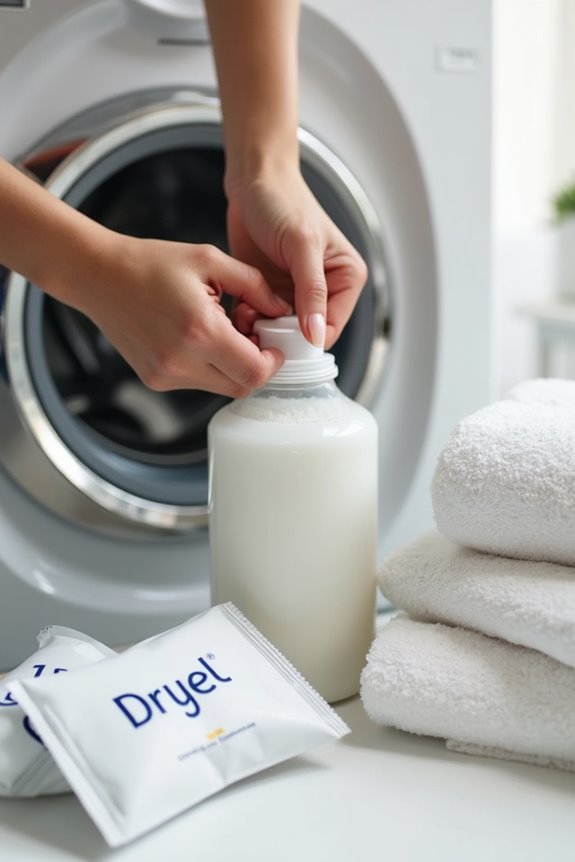
To keep our clothes looking fresh and stain-free, we need to pay attention to how we use our washing machines. First, let’s make certain we’re using the right washer settings. If we overload the machine, we risk trapping detergent in the folds of our clothes. It’s best to fill the washer to about 75% capacity. Next, remember to use the designated detergent compartments. This guarantees even distribution. Choosing the right detergent types matters too. High-efficiency detergents work best for HE washers, and we should stick to the recommended amounts—usually just 1-2 tablespoons. Additionally, hard water can react with detergents and lead to stains, so it’s essential to consider specific formulations designed for hard water conditions. And don’t forget to check the water quality! Hard water can react with detergents and lead to stains. Let’s keep our laundry game strong!
Techniques for Specific Types of Stains
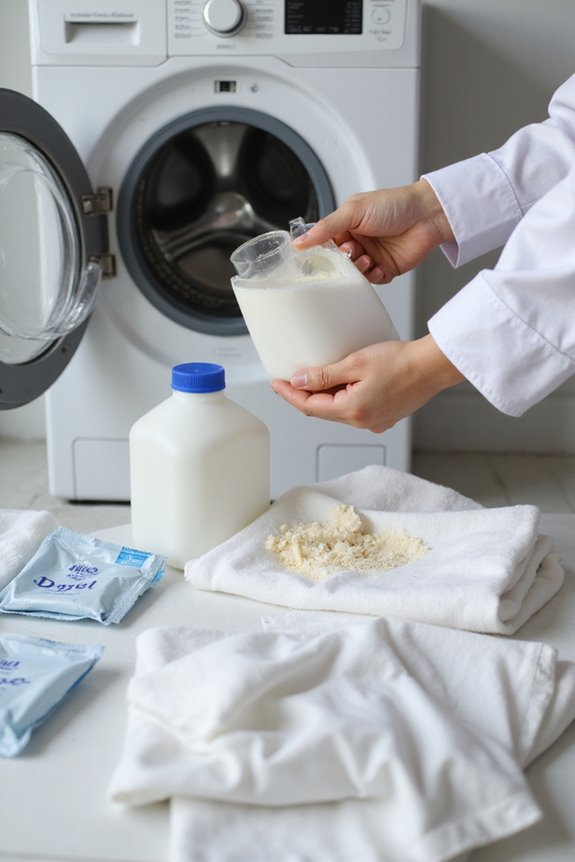
When it comes to tackling stubborn stains on our clothes, knowing how to handle specific types can make all the difference. For liquid laundry detergent stains, we should soak the garment in warm water first. Then, we can apply an oxygen-based pretreatment directly on the stain and let it sit for about 10 minutes. If we’re dealing with powdered detergent stains, rubbing alcohol can work wonders, especially with oily residues. Additionally, using plant-based surfactants can enhance the effectiveness of stain removal for various types of fabrics. But what about delicate fabrics? We need to take extra care! Gentle blotting is key, and we should always test any solvent on a hidden patch first. Using soaking techniques with warm water and a bit of vinegar can help dissolve those pesky residues. Let’s keep our clothes looking great!
Post-Treatment Care and Prevention Tips
While we might think we’ve conquered detergent stains, post-treatment care is just as important to guarantee our clothes stay stain-free. First, let’s focus on post-treatment maintenance. Always rinse stained areas with cold water right after spotting them. Soaking them in a mix of warm water, mild dish soap, and distilled white vinegar can work wonders too. Additionally, consider using detergents with effective odor-fighting ingredients to help prevent future stains and odors from setting in.
When washing, don’t overload the machine—give those clothes some room to breathe! For storage solutions, keep our washing machine clean to avoid transferring any detergent residue back onto our clothes. Finally, let’s remember to check those garment care labels. By following these simple tips, we can keep our clothes looking their best and avoid future mishaps. Happy washing!
Frequently Asked Questions
Can I Use Fabric Softener on Detergent-Stained Clothes?
Using fabric softener on detergent-stained clothes isn’t advisable. Instead, we should focus on detergent stain prevention first. Let’s explore effective fabric softener tips to enhance our laundry experience after successfully removing any stains.
What Types of Fabrics Are Most Prone to Detergent Stains?
In the tapestry of our laundry lives, we find cotton blends dancing gracefully, while synthetic fibers cling stubbornly. Together, we navigate the pitfalls of detergent stains, knowing tighter weaves often weave trouble into our clothes.
How Can I Tell if a Stain Is Detergent-Related?
When we’re identifying stains, we should look for detergent residue’s distinct characteristics. If we notice waxy patches or blue streaks, it’s likely detergent-related, helping us in effective stain identification for our laundry.
Is It Safe to Mix Different Detergent Brands?
When considering mixing brands, we should be cautious due to detergent compatibility concerns. Following mixing brands advice, it’s best to use one detergent at a time for ideal cleaning and to avoid potential issues.
Can Detergent Stains Be Removed From Colored Fabrics?
Ever wondered if we can rescue our favorite colored fabrics from pesky detergent stains? With proper detergent stain removal techniques and attentive colored fabric care, we can definitely restore them to their vibrant selves!

